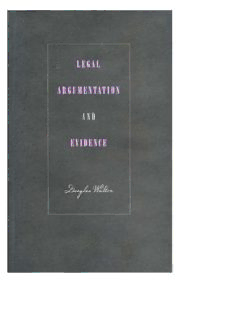Table Of ContentLEGAL
ARGUMENTATION
AND
EVIDENCE
..........................9541$$ $$FM 07-24-0211:42:43 PS
..........................9541$$ $$FM 07-24-0211:42:43 PS
L E G A L
A R G U M E N TA T I O N
A N D
E V I D E N C E
Douglas Walton
the pennsylvania state university press
university park, pennsylvania
..........................9541$$ $$FM 07-24-0211:42:44 PS
LibraryofCongressCataloguing-in-PublicationData
Walton,DouglasN.
Legalargumentationandevidence/DouglasN.
Walton.
p. cm.
Includesbibliographicalreferencesandindex.
ISBN0-271-02177-2(cloth:alk.paper)
1.Law—Methodology. 2. Evidence
(Law). 3. Logic. 4. Reasoning. I. Title.
K213.W35 2002
347(cid:1).06—dc21 2001055956
Copyright(cid:1)2002ThePennsylvaniaStateUniversity
Allrightsreserved
PrintedintheUnitedStatesofAmerica
PublishedbyThePennsylvaniaStateUniversityPress,
UniversityPark,PA16802–1003
Thepaperusedinthispublicationisbothacid-free
andtotallychlorine-free(TCF).Itmeetsthe
minimumrequirementsofAmericanNational
StandardforInformationSciences—Permanenceof
PaperforPrintedLibraryMaterials,ANSI
Z39.48–1992.
..........................9541$$ $$FM 07-24-0211:42:44 PS
CONTENTS
Acknowledgments ix
Introduction xiii
1 SPECIALFEATURESOFARGUMENTATIONINA
LEGALSYSTEM 1
LegalRulesandParticularCases 3
InterpretationofStatutesandDocuments 6
StagesofaTrial 9
CivilLaw,CriminalLaw,andBurdenofProof 11
Evidence 15
RelevanceandAdmissibility 19
TestimonyofWitnesses 23
ExpertTestimony 25
Examination 26
DependenceonPrecedents 29
2 FORMSOFARGUMENTCOMMONLYUSEDINLAW 34
ArgumentfromAnalogy 35
ArgumentfromanEstablishedRule 39
ArgumentfromSignandAbductiveArgument 41
ArgumentfromPositiontoKnow 45
ArgumentfromVerbalClassification 51
ArgumentfromCommitment 53
PracticalReasoning 56
ArgumentfromPersonalAttack(AdHominemArgument) 59
TheSlipperySlopeArgument 63
OtherImportantFormsofArgument 66
v
..........................9541$$ CNTS 07-24-0211:42:52 PS
vi
contents
3 CIRCUMSTANTIALEVIDENCE 73
TheMcCormickCriterion 74
TheJewishClassicalLawCriterion 77
BenthamonCircumstantialEvidence 80
Patterson’sCriterion 83
WigmoreonDirectEvidenceandAutopticProference 85
WigmoreonCircumstantialandTestimonialEvidence 88
TheHopeHeadCase 91
TheFiveCriteriaSummarized 93
HowUsefulistheConceptofCircumstantialEvidence? 97
LogicalDifficultiesofCircumstantialEvidence 99
4 PLAUSIBILITYANDPROBABILITY 103
AThirdTypeofReasoning 105
PlausibilityandProbability 108
WigmoreonLogicalInferenceandProbativeValue 114
LockeonPlausibilityandDegreesofAssent 122
BenthamonPlausibilityandEvidence 124
PlausibilityandCasuistry 128
PlausibleReasoningintheAncientWorld 133
Carneades’TheoryofPlausibility 138
CriteriaandApplicationsofCarneades’Theory 141
WhytheNeglectofPlausibleReasoning? 146
5 THEDIALECTICALFRAMEWORKOFLEGAL
ARGUMENTATION 151
ImplicatureandConversationalPostulates 153
RationalPersuasionintheTrial 156
NormativeModelsofArgumentation 160
PersuasionDialogue 165
OtherTypesofDialogue 171
PeirasticDialogueandExtasticDialogue 174
RelevanceandDialecticalShifts 180
TheFairTrialandtheWitch-Hunt 184
..........................9541$$ CNTS 07-24-0211:42:52 PS
vii
contents
ADialecticalTheoryofStatutoryInterpretation 187
ArgumentationSchemes,Fallacies,andLegalLogic 194
6 APLAUSIBILISTICTHEORYOFEVIDENCE 199
ComponentsoftheNewTheory 200
EvidenceandArgument 205
TheProbativeFunction 214
AncientRootsoftheNewTheory 216
AdvantagesofThePlausibilisticTheory 223
ScientificEvidence 227
LogicalandLegalRelevance 230
LegalEvidence,Credibility,andPlausibility 234
ExpertTestimonyasEvidence 239
ProblemsandConclusions 243
7 RELEVANCEINPERSUASIONDIALOGUE 248
PersuasionDialogue 249
ChainingofArguments 252
RulesofDialogueandFallacies 258
TheFallacyofIrrelevantConclusion 260
TheMethodofArgumentExtrapolation 262
TestinganActualExample 266
HowtheMethodShouldbeApplied 269
QuestionsRaised 271
ApplicationtoLegalCases 274
ArgumentsandExplanations 279
8 MULTI-AGENTARGUMENTATIONANDCREDIBILITY 282
FormalDialogueSystemsinLogic 283
TheAdHominemandAdVerecundiamFallacies 287
LabeledDeductiveSystems 296
Multi-AgentSystems 298
AddingAgentstoFormalDialecticalStructures 301
EvaluatingFallaciesandBlunders 304
HowShould‘Agent’beDefinedinFormalDialectic? 306
..........................9541$$ CNTS 07-24-0211:42:53 PS
viii
contents
DialecticalShiftsandRelevance 308
TheSolutiontotheProblem 313
Conclusions 317
9 HOWTOUSETHENEWMETHOD 321
TheNewMethod 322
InferenceFormsandCriticalQuestions 325
ArgumentsDependingonTestimonyandCredibility 329
VerbalArgumentsandCriticalQuestions 334
TheTrialasPersuasionDialogue 335
ArgumentDiagramming 338
TheFormalStructureofDiagramming 342
FormalizingtheNewSystem 345
TheSubtletiesofPeirasticDialogue 348
TheCurrentProblemswithRelevance 350
Bibliography 357
Index 365
..........................9541$$ CNTS 07-24-0211:42:53 PS
ACKNOWLEDGMENTS
Even though I have been working on legal argumentation and evidence for
some time, and have written some papers on the subject, the idea that there
was a need for a book on it was not at first apparent to me. What suggested
suchanideawasavisitto NotreDameLaw SchoolinNovember 1997, when
I gave an invited lecture on legal argumentation as part of a symposium on
legallogic.Thesymposium,andindividualconversationswiththeparticipants,
showedmetheneedforbringingtheresourcesofargumentationtheorytobear
onfundamentalproblemsinevaluatinglegalreasoning.Inparticular,itseemed
tomethatthekindofreasoningusedinevidencelawwasvirtuallyunexplored
territory, from a logical point of view, that badly needed some insight on its
underlying structure of argumentation. The participants at this symposium
showedmethatalthoughformallogicisimportantinidentifyingtheinferential
structuresoflegalreasoning,therewerevastareasoflegalargumentationthat
simplycriedoutforanalysesbythemorepracticalandcontextualcase-by-case
methodsofinformallogic.
IwouldliketothankKevinSaunders,RichardFriedman,JohnRogers,Rob-
ert Rodes, Patricia Sayre, Larry Alexander, Howard Pospesel, and Layman
Allen for their open-minded willingness to listen to a new and not widely ac-
ceptedpointofview.Chapter5 isbasedontheinvitedlectureIgaveatNotre
DameLawSchoolonNovember15,1997. Therevisedversionofthislecture
waspublishedas‘‘APragmaticModelofLegalDisputation,’’NotreDameLaw
Review 73 (1998): 711–35. Chapter 8 is based on parts (in revised form) of
threepreviouslypublishedpapers.Onepaperwasoriginallyaninvitedkeynote
lecturegivenattheInternationalConferenceonFormalandAppliedPractical
Reasoning, FAPR ’96, in Bonn, Germany, in June 1996. The paper later ap-
pearedinpublishedformas‘‘HowCanLogicBestBeAppliedtoArguments?,’’
LogicJournaloftheIGPL[InterestGrouponPureandAppliedLogic]5(1997):
603–14.Thesecondpaper,‘‘EthoticArgumentsandFallacies:TheCredibility
Function in Multi-Agent Dialogue Systems,’’ was published in Pragmatics and
ix
..........................9541$$ $ACK 07-24-0211:43:00 PS
Description:A leading expert in informal logic, Douglas Walton turns his attention in this new book to how reasoning operates in trials and other legal contexts, with special emphasis on the law of evidence. The new model he develops, drawing on methods of argumentation theory that are gaining wide acceptance i

